Insect & Disease Conditions Update
A printer-friendly version of this report is available on-line from the Conditions Report Index.
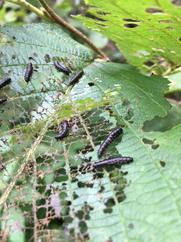 Alder flea beetles (Altica ambiens)
– We have received several calls
this month about alder flea beetles. The larvae of the beetles are sometimes mistaken for black ‘caterpillars’.
They feed on tissue between the veins of
leaves, leaving holes, and eventually skeletonizing the leaf. In observing the 1910’s
outbreak of this insect, Woods recorded mortality of individual stems due to
heavy feeding (MAES Bulletin 265, 1917).
Although Maine is currently experiencing an outbreak of these insects this
is not considered a significant pest in Maine due to the lack of economic
importance of alder and the ability of alder, as a whole, to recover from
epidemics.
Image: Alder flea beetle larvae feeding on speckled alder. Kathy
Foley.
|
Asian longhorned beetle (Anoplophora glabripennis) – Asian
longhorned beetle has not been found in Maine.
Early detection is important and is most likely to happen if people like
you learn how to identify it and the signs and symptoms of its damage, as well
as share that information with others and take time to look at
trees. In 1904, Maine entomologist Edith
Patch wrote of browntail moth and other orchard pests, “…It is the deserted or
neglected trees that are to be feared, for in them many species of caterpillars
dangerous to the orchard trees breed unnoticed, perhaps for years, until they
become numerous enough to make conspicuous ravages...” (MAES Bulletin
108). More than 100 years later, this
rings true in regards to Asian longhorned beetle and other novel threats to our
trees. It is the deserted and neglected
trees that will harbor these pests un-noticed.
You may have read or seen
elsewhere that August is “Tree Check” month.
One of the main reasons behind that is it is a great time of year to be
hyper-aware of Asian longhorned beetle.
Signs and symptoms of attack, such as frass and weeping sap, are at
their most visible this time of year.
The adults may begin emerging from host trees as early as the 4th of
July, but in most years, peak emergence wouldn’t happen until the end of August
or early September. You can find information on
how to recognize Asian longhorned beetle on the Department's website (accessed from the sidebar of www.maine.gov/alb).
If you would like more in depth
information, there are many learning opportunities. In the Calendar section at the end of this
report there is a list of several upcoming opportunities to learn more about
the threat of Asian longhorned beetles and others and how to recognize them and
report suspected detections.
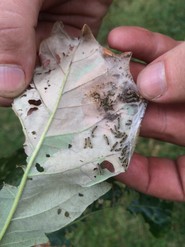
Browntail
moth (Euproctis
chrysorrhoea) – Browntail moth caterpillars are now hatching from their
furry egg masses on the leaves of host trees – primarily oak and apple. The
tiny larvae will feed by skeletonizing leaves and leaving the veins behind.
Their feeding can be confused with that of fall webworm but the webworm larvae
are over an inch in size now, whereas the browntails will be less than ¼ of an inch.
Image: Immature browntail moth larvae in webbing on the underside of a leaf. Maine Forest Service.
There were moth flights reported in July from the
usual Midcoast area but not in particularly large numbers. Light traps in
Freeport and Hope picked up hundreds of moths so they are still out there. But,
when we looked for locations to run some control trials, we came up empty. We
have been looking at small trees, i.e. apple, young oak, hawthorn, etc., and
have searched from Turner to Yarmouth up to Phippsburg and in between. We have
found very few egg masses down low and in many places are not seeing much
feeding yet when using binoculars to look at the tops of large trees. There are
still hot spots in areas such as Eddington and Burnham, far outside the usual
browntail area, where large trees are affected.
We are NOT saying browntail is gone, but it may not be as bad next year
in many places.
It is still early in the survey season, so stay
tuned. If you are thinking of treating trees now, it would be worth it to
closely inspect the trees to see if there are browntails skeletonizing the
leaves and starting their winter webs.
|
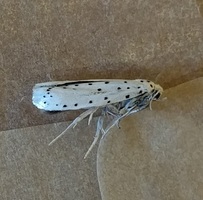 Probably an Ermine moth (Yponomeuta sp.) – A spectacular display by uglynest caterpillars was reported in the last Conditions Report. It was an anticipated case of mistaken identification! Some caterpillars were kept for rearing due to uncertainty in the identification. The insects were easy to rear from late-instar caterpillars, and more than a half dozen moths were collected. However, visiting carpenter ants at the lab thought the carefully prepared specimens left to dry were a very cleverly plated feast (you knew they don’t eat wood, right?). The webbing that decorated Tilia sp. in Hebron was most likely caused by an ermine moth species. The remaining intact moth (kept separate because it was too dry to pin), will be sent away for identification—probably a better avenue than making assumptions based on host and appearance (we’ve been down that road before, see June report). If that is not adequate for a firm ID, we’ll be back in Hebron next June to take more samples for a positive ID on the phantom webber. So far light trap catches from two other locations – South Berwick and Freeport – have yielded similar moths.
Image: Moth whose larvae defoliated and webbed Tilia sp. in Hebron
in June. Maine Forest Service.
|
Fall webworm (Hyphantria
cunea) – The webs of fall
webworm caterpillars are quite visible now; building of the webs was underway
by mid-July but additions will continue until the caterpillars pupate later
this season. Although unsightly, feeding
from this insect does not cause significant damage to its host. If you want to reduce aesthetic impacts, it
is best to start looking for this pest in July.
Two low-impact ways to reduce aesthetic damage are to clip and relocate
webs or wash them from the tree with a concentrated blast from a garden hose.
Both methods may require follow-up and should be employed when the webs first
begin to form.
Fall webworm webs can be confused with browntail overwintering
webs. The fall webworm webs are much
looser and larger than those of the early larval instars of browntail
moth. Another way to distinguish the
webs is to look at their occupants.
Browntail moth caterpillars are tiny (less than ¼ of an inch), the two
bright-orange glands on their tail-ends are not orange in these early instars,
but they are there as yellow spots. Fall
webworm caterpillars, just like their webs, are larger (more than ½ of an inch
in most places by now).
Fir coneworm (Dioryctria abietivorella) – In 2016 we
had a Christmas tree grower report this insect mining the terminal bud cluster
of leaders and boring into terminal shoots in plantation balsam fir trees. The
damage came after a heavy cone year in 2015. Despite the name, fir coneworm
will infest cones and shoots of several conifer species (see below). 2017 has been another banner year for cone
crops — to the point that white pine crowns are now distorted by the weight of
the cones and since late May it has been possible to watch the development of
cones on fir at highway speed. In Christmas tree plantations, this is an insect
to watch for in 2018.
DETAILS of HOSTS and PLANT PARTS ATTACKED by D. ABIETIVORELLA from Whitehouse et al. in Can Ent. 143: 1-34 (2011).
HOSTS: Fir Species, Spruce Species, Douglas-fir, Jack Pine, Lodgepole Pine, Red Pine, Scots Pine, White Pine
PLANT PARTS: Healthy cones, Damaged second-year cones, Needles, Shoots, Cambium
Hemlock
woolly adelgid (Adelges tsugae) – The detection of hemlock woolly adelgid (HWA) in
three counties of southwest Nova Scotia this month is an important reminder
that this hard-to-detect insect could be, undetected, in forests of interior
and Downeast coastal Maine. To date, any
HWA found east of Camden has been thought to be associated with artificial spread,
and populations have not been found in forest trees in that area. However, it is worth taking a regular look at
hemlocks outside the known infested area in Maine (map below) for the tell-tale
white, wispy material covering adelgid on the twigs of hemlock trees.
This is not the easiest time of year to spot HWA;
the white ‘wool’ hasn’t been refreshed since June, and the adelgid is dormant
until mid-October. However, it is a good
time from the perspective of accidental spread.
This time of year, adelgid eggs and crawlers are unlikely to be present,
and adelgid cannot be accidentally moved on clothing and equipment. Risk of spread on anything except rooted
hemlock picks up again in mid- to late-winter.
Information on identification of HWA is available
on-line. If you think you have found HWA
outside the area mapped, please let us know.
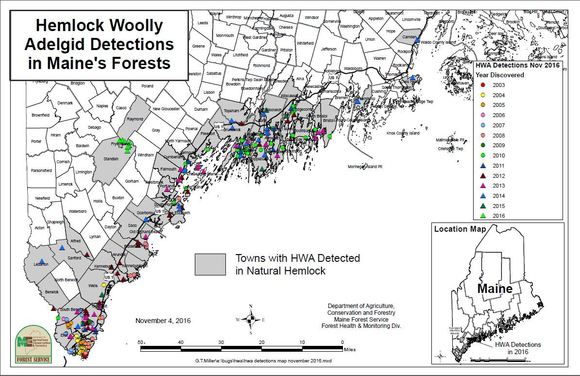 Above: Map of hemlock woolly adelgid detections in Maine's Forests
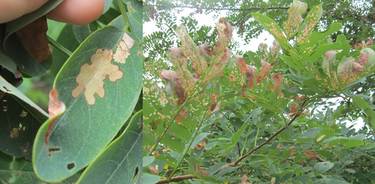 Locust leafminer and locust digitate leafminer (Odontota dorsalis and Parectopa robiniella) – The scorched appearance of black locust trees is being noted around the state. Significant skeletonizing and mining is being done by a leaf-mining beetle, Odontota dorsalis. This is the second year of an outbreak of the locust leafminer and it appears to be more widespread than in 2016.
Images: A mine of the locust digitate leafminer, a gracillariid
moth (left) and larval mines and adult skeletonizing damage caused by the
locust leafminer, a chrysomelid beetle (right), Old Town, ME. Maine Forest Service.
In addition to the locust leafminer, mines of a delicate moth species, the locust digitate leafminer, can also be found on the foliage of affected trees. The previous outbreak of locust leaf-mining beetles in Maine caused branch dieback and some locust mortality. With the addition of the digitate leafminer, we may see more mortality – or it may all just go away.
|
 Psocids
(Family Phosidae) – Psocids
(sometimes called common barklice)
are small soft-bodied insects often seen in
groups or tiny herds on the surface of tree bark where they feed on lichens, fungi, and other
superficial plant materials. They are
members of the insect order Psocoptera. The species
Cerastipsocus venosus is one of the most common of the species that occur in Maine and can often
become very abundant. These psocids
appear in July as patches of tiny tan specks on the bark of various hardwoods and conifers. Individuals are less than 3/16 inches (5 mm) long. They can also be found on rocks, fence posts, picnic tables, etc. As they mature
they turn gray with lighter cross-banding.
Adults have dark smoky-gray wings with a triangular
light spot on each forewing. The wings are held roof-like and almost vertically over the body at rest, and the psocids bear some resemblance to aphids. However, unlike aphids, which possess a beak for sucking plant juices, psocids have chewing mouth parts. The young live in the same manner as adults; differing principally in the lack of wings which develop in pads on the back during later stages.
Image: Barklice on the main stem of a tree. Submitted by a client from
Farmingdale.
Adult females deposit their
eggs singly or in small clutches on the
bark or wherever the group finds its food, and cover each mass with a series of tiny silk strands.
Psocids usually disappear soon after
they develop wings in mid- to late-August. Winter is spent in the egg stage.
Bark lice cause no harm to trees and controls are not necessary.
|
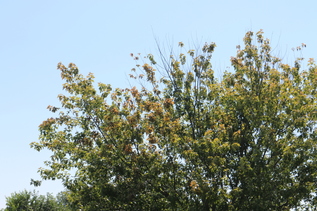 Maple stress symptoms have been noticeable in different forms across Maine since early spring. Later growing season symptoms reported from various parts of Maine include premature fall coloration and progressive branch dieback in a top-down pattern.
Image: Typical thin crown and beginning top dieback in a maple tree. Maine Forest Service.
Leaves continue to be undersized leading to a thin appearance of the canopy. Early fall coloration is a typical symptom of stress in maples. This can be seen on specific branches, sections of trees and even entire trees. Crown dieback can occur due to several situations, but this year it is believed to be due to fine root dieback during the extended drought of last year. The impacts of last year’s prolonged period of water deficit may be seen for the next few years as secondary pests take advantage of weakened trees.
|
Spruce needle cast diseases – Since 2016 an effort has been underway to better
understand the distribution of the two main spruce needle cast diseases causing
defoliation in Maine. Of particular interest is the distribution of Stigmina needle cast, which has recently
been acknowledged as a spruce needle disease of significance in the region.
While MFS staff have collected samples from symptomatic trees during their
normal duties and landowner samples have been documented, more samples would be
greatly appreciated. If you have any species of spruce tree showing symptoms of
needle loss in the lower third of the canopy and you would like to have the
tree diagnosed, feel free to send in a sample to the Augusta lab, care of Aaron
Bergdahl, forest pathologist. In order for a sample to be diagnosed, needles
from several age classes are needed (see figure below). Place a branchlet like
the one pictured below in a sealed paper envelope and send to: 168 State House
Station, Augusta ME, 04333. Any contributions to the better understanding of
spruce disease distribution in the state of Maine are greatly appreciated.
Below: A spruce branchlet showing symptoms of spruce needle cast
disease. Each needle age class is indicated by the numbers labelling each
bracketed section of growth. Note the lack of needles in the 3- and 4-year age
classes. These needles, although sparse, are the most important for disease
diagnosis and must be included in a submitted sample. Image: Maine Forest Service
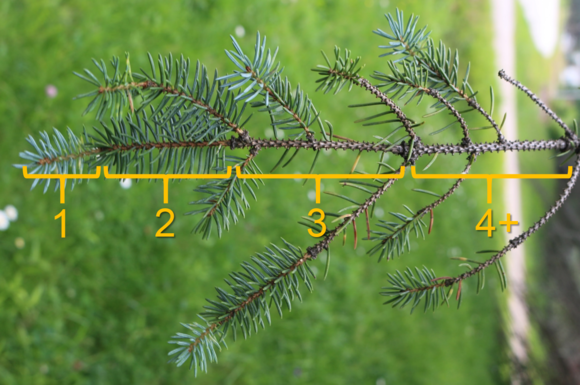
Oak wilt has not been detected in Maine but is a pathogen of significant concern and therefore a focus of early detection efforts. The causal agent of oak wilt, Ceratocystis fagacearum, has been confirmed in three locations on Long Island, New York; one location in eastern New York; and one location in western New York. This disease has caused mortality of oaks in the Midwestern United States for decades and is a threat to oaks in natural and residential areas there.
The oak wilt fungus spreads via the water conducting tissue (xylem) leading to wilting and killing of branches (flagging). As the disease progresses in the tree, wilting and branch mortality expands, with trees typically dying in the same year. Mortality has been recorded after as little as five weeks post infection. Once a tree is infected, it will not recover.
Oak trees have a habit of connecting their roots with neighboring oak trees (root grafting). This can allow the oak wilt fungus to spread from tree to tree rapidly, causing pockets of oak mortality in a stand. Trees infected with the oak wilt fungus via root grafts die quickly. The disease can persist in white oak group oak trees causing noticeable, but less-severe symptoms and overall slower decline.
Wounding of oak trees via pruning or otherwise during the growing season should be strictly avoided in areas where the oak wilt pathogen is present. This is because sap-feeding beetles spread the disease from the fungal structures formed by oak wilt fungus that produce sweet, spore-filled liquid. The beetles are also attracted to sap produced at tree wounds. If the beetle visits a fungal structure and becomes coated with spores as it feeds and then visits a wound site on an oak tree, the fungus will likely be successfully transmitted. If wounds occur in summer, they should be sealed or dressed in a way to prevent beetles from making contact with the wound. Options include water-based latex paint and other tree wound dressing products.
Underground root grafting junctions must be broken around infected trees to avoid spreading the disease to neighboring trees. This is accomplished by deep trenching around infected removed trees or efficient stump and root removal. Trees that die in the summer must be removed from the site and dried by debarking, splitting, chipping or burning the wood. This prevents the possible formation on cut trees of the spore-producing fungal pads that are effective in disease transmission.
Again, oak wilt has not been found in Maine. However, if you encounter symptoms described and pictured here in red oak trees, please contact the Augusta lab at the number below for further evaluation.
Below: Left: Oak leaves shed in July from a tree in Pennsylvania
confirmed to be infected with the oak wilt disease fungus (Maine Forest Service). Right: In the
foreground, tree that died from oak wilt disease and a smaller neighboring tree
in decline due to the disease(Isabel Munck, USFS)
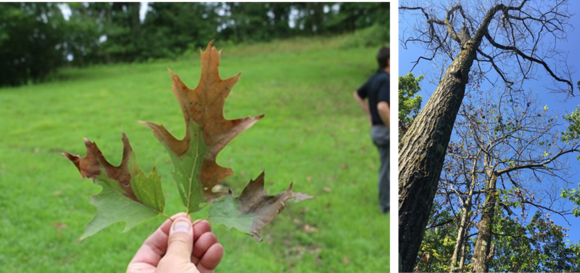
Maine
Woodland Owners and Tree Farm Field Day, September 9th, Milford,
ME. The 63rd Maine Woodland Owners and Maine Tree Farm Forestry
Field Day will be based at the Maine Youth Fish and Game Camp, in Milford on
the Stud Mill Road. Bring your forest
insect and disease questions. The event honors the 2017 Maine Outstanding Tree Farmers,
Pam and Bryan Wells, owners of the Wells Demonstration Forest. More details are available at the Maine Woodland Owners website.
Common
Ground Fair, Sept 22nd – 24th, Thorndike, ME. Allison Kanoti will be talking about forest insects hosted
by the Maine Woodland Owners Association in the Low Impact Forestry Tent at 2pm Sept 22. Throughout the fair, Maine Forest Service will have a booth
in the Low Impact Forestry Area, and our division will have a separate display
in the Maine Indian Basketmakers’ tent focused on emerald ash borer. http://www.mofga.org/TheFair/tabid/135/Default.aspx.
Bug
Maine-ia, September 12th, Augusta, ME. The Maine State Museum gets
creepy and crawly as Bug Maine-ia invades! This is a great learning experience
for kids and adults with bugs from Maine and around the world (many living)
converging under one roof! Admission is FREE. http://mainestatemuseum.org/.
Invasive
Forest Pest Presentations, August - November
Maine Soil & Water
Conservation Districts, under a grant from the Invasive Forest Pest Outreach
Project of the Department of Agriculture, Conservation and Forestry, are
offering a series of free presentations in August and September for
landowners and users, landscape and forest professionals, and all residents of
the state. Presentations are designed to help participants identify current and
potential invasive forest pests and their host species, understand the threats
to our forests and woodlands posed by these pests, and learn how to report
suspected pest sightings or damage to trees that may be a result of pest
infestations.
-
Tue, August 15 from 5:30-7pm at Thompson Library, 186 E Main
St, Dover-Foxcroft. FMI: 564-2321 x3
-
Wed, August 16 from 6-7:30pm at Machias Blueberry Festival,
Machias FMI: Nate Pennell, 255-4659
-
Wed. August 30 from 6:30-8pm at Belgrade Lakes Center, 137
Maine St, Belgrade Lakes, FMI: Dale Finseth, 622-7847 x3
-
Wed, September 6 from 5:50-7pm at Topsham Public Library, 25
Foreside Rd, Topsham FMI: Josie Lahey, 251-3574
-
Tue, September 12 from 6:30-8pm at Rockland Public Library, 80
Union St, Rockland FMI: Hildy Ellis, 596-2040
-
Sat, September 16 from 1-3pm at Belgrade Lakes Center, 137 Maine
St, Belgrade Lakes FMI: Dale Finseth, 622-7847 x3
-
Tue, September 19 from 5-7pm at Region III Vocational School, 35 W. Broadway, Lincoln FMI: Amy Polyot 947-6622 x3. Registration required.
Also, look for invasive forest pest displays at the following upcoming
events:
-
August 19-26 Union Fair (Knox County)
-
August 23 & 24 Maine Farm Days in Clinton (Kennebec
County)
-
August 26 Acton Fair (York County)
-
September 9 Wells Forest Tree Farm Field Day in Milford
(Penobscot County)
-
September 18 Farmington Fair Ag Day (Franklin County)
-
September 22-24 Common Ground Country Fair in Unity (Waldo
County)
-
October 14 A
Day in the Woods at Hidden Valley Nature Center in Jefferson (Lincoln
County)
-
November 11 Craig Brook Fish Hatchery Spawning Festival in East Orland
(Hancock County); display & mini-presentations throughout the day
-
November 11 & 12 Maine Harvest Festival in Bangor (Penobscot
County)
Office hours are 7:30 a.m. to 4:00 p.m., Monday through Friday, except
for holidays. If you plan to visit
either office, you may wish to call ahead just to make sure someone will be
present to meet with you. (207) 287-2431 (Augusta) and 827-1813 (Old Town)
Conditions Report No. 4, 2017
On-line: http://maine.gov/dacf/mfs/publications/condition_reports.html
Department of
Agriculture Conservation & Forestry
Maine Forest Service - Forest Health and Monitoring
Contributors: Aaron Bergdahl, Charlene Donahue, Allison
Kanoti, Colleen Teerling
|